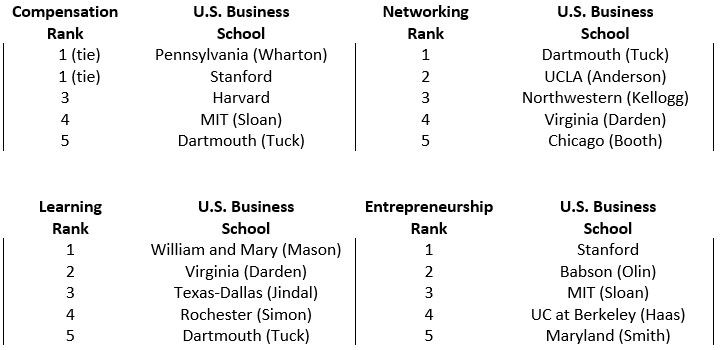November 4, 2019

Dartmouth College’s Tuck, Harvard Business School, University of Chicago’s Booth, and University of Virginia’s Darden
Round Out U.S. Top Five
NEW YORK (November 4, 2019)—Bloomberg Businessweek today released its 31st ranking of the best U.S. business schools, based on data compiled from more than 9,000 students, 14,920 alumni, 900 corporate recruiters, and compensation and job-placement data from each school. Stanford takes the number one spot among 94 full-time U.S. MBA programs, followed by Dartmouth (Tuck) at number two, and Harvard at number three. This year is the second in a row that Stanford came out on top.
Below are Bloomberg Businessweek’s 2019-20 top 20 U.S. full-time MBA programs (alongside their 2018 ranks).
| 2019-20 Rank | U.S. Business School | 2018 Rank |
| 1 | Stanford | 1 |
| 2 | Dartmouth (Tuck) | 19 |
| 3 | Harvard | 3 |
| 4 | Chicago (Booth) | 5 |
| 5 | Virginia (Darden) | 9 |
| 6 | Pennsylvania (Wharton) | 2 |
| 7 | MIT (Sloan) | 4 |
| 8 | UC at Berkeley (Haas) | 6 |
| 9 | Columbia | 7 |
| 10 | Northwestern (Kellogg) | 8 |
| 11 | Cornell (Johnson) | 10 |
| 12 | UCLA (Anderson) | 17 |
| 13 | NYU (Stern) | 13 |
| 14 | Yale | 11 |
| 15 | Carnegie Mellon (Tepper) | 12 |
| 16 | Washington (Foster) | 16 |
| 17 | Michigan (Ross) | 18 |
| 18 | North Carolina (Kenan-Flagler) | 23 |
| 19 | Georgetown (McDonough) | 20 |
| 20 | Duke (Fuqua) | 15 |
Highlights from this year’s ranking:
- New to the top 10 is Dartmouth (Tuck), which rose from 19 to 2.
- Falling out of the top 10 is Cornell (Johnson), which fell from 10 to 11.
- Climbing into the top 20 is North Carolina (Kenan-Flagler), which rose from 23 to 18.
- Falling out of the top 20 is USC (Marshall), which fell from 13 to 22.
In addition to the overall ranking, schools are separately ranked on four component indexes — compensation, networking, learning, and entrepreneurship — providing students more ways to evaluate what schools have to offer them. Below are Bloomberg Businessweek’s top 5 rankings for each of the four indexes.

The complete 2019-20 rankings of all 94 full-time U.S. MBA programs, including the four indexes and methodology, can be found here: bloomberg.com/business-schools
Bloomberg Businessweek highlights school-specific data for each MBA program including average GMAT, median starting salaries, tuition costs, and on-campus atmospheres for groups that are traditionally underrepresented in MBA programs. This year, a new interactive tool allows readers to customize a short list of schools that provides side-by-side comparisons of overall rankings, component indexes, total number of graduates, and median base salary.
The top 30 full-time U.S. MBA programs will be highlighted in the print issue of Bloomberg Businessweek on newsstands Friday, November 8, 2019.
Bloomberg Businessweek will announce the 2019-20 Global Business School ranking on December 4, 2019.
Methodology:
Schools are ranked on four indexes: Compensation, Learning, Networking, and Entrepreneurship. Rather than assign weightings ourselves, we surveyed students, alumni, and recruiters to learn what was most important to them. Their answers determined each index’s weighting. Combining that information with results of our other surveys and compensation data, we calculated the overall rankings.
We canvassed 9,016 students, and a total of 14,925 alumni took our survey. The number of participating recruiters at business schools was 985.
All schools submitted employment data for the Class of 2018 following standards set by the MBA Career Services & Employer Alliance, a trade group founded in 1994 to collect consistent, comparable, peer-reviewed data. Schools were then given surveys to send to students who graduated from Oct. 1, 2018, to Sept. 30, 2019; alumni who graduated from Oct. 1, 2010, to Sept. 30, 2013; and employers that recruited graduates for full-time positions in 2017 and 2018. Schools had to abide by Bloomberg’s Code of Ethics, meant to ensure that all respondents participate voluntarily, without bias or pressure from school officials or their peers.
We set minimum thresholds for response rates based on the size of a school’s graduating and alumni classes, as well as for its employment data; schools that didn’t meet these thresholds were eliminated.
The complete list of 94 schools and a detailed methodology are available at bloomberg.com/business-schools.
# # #
Contact:
Raina Dembner, rdembner@bloomberg.net